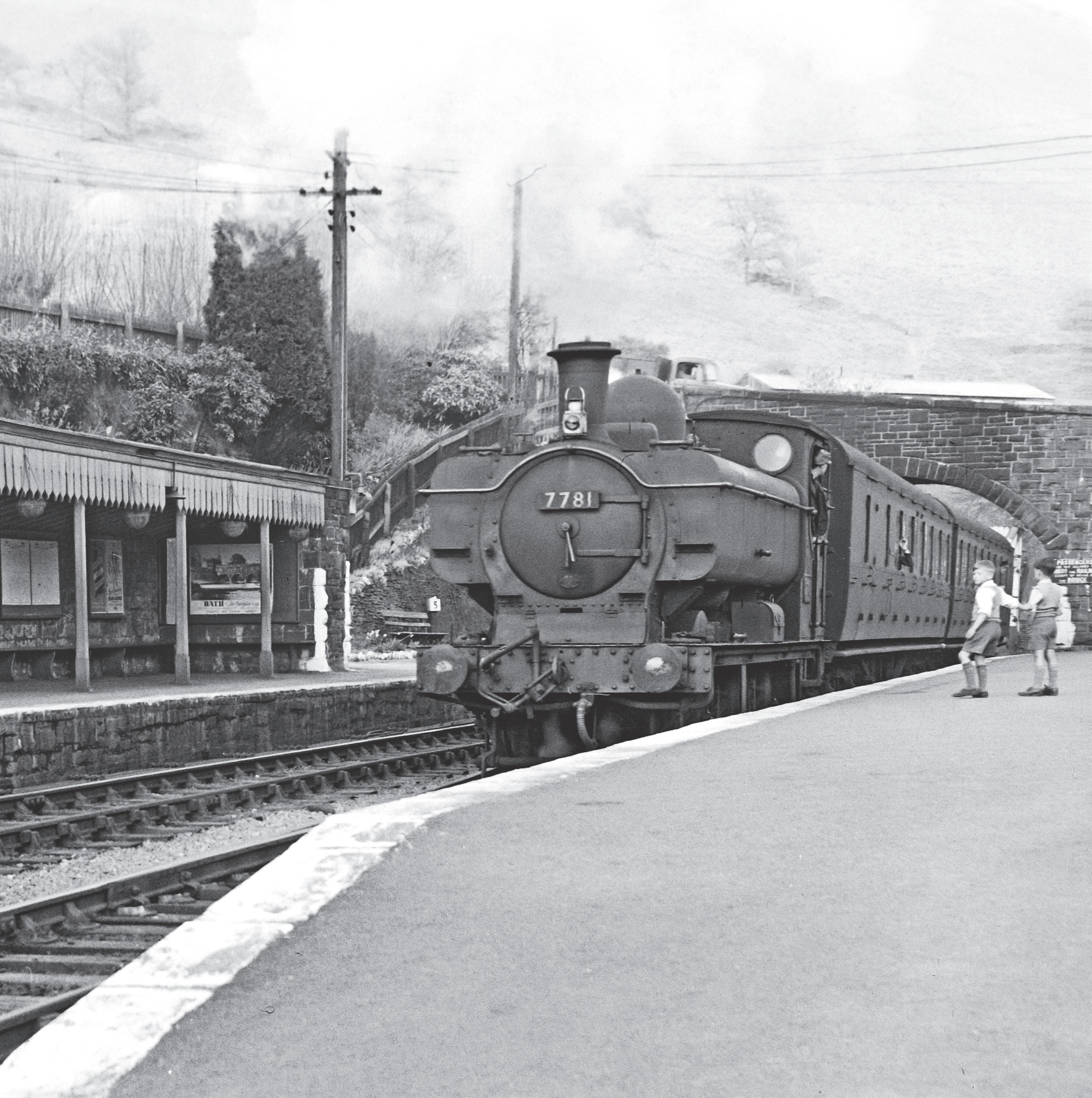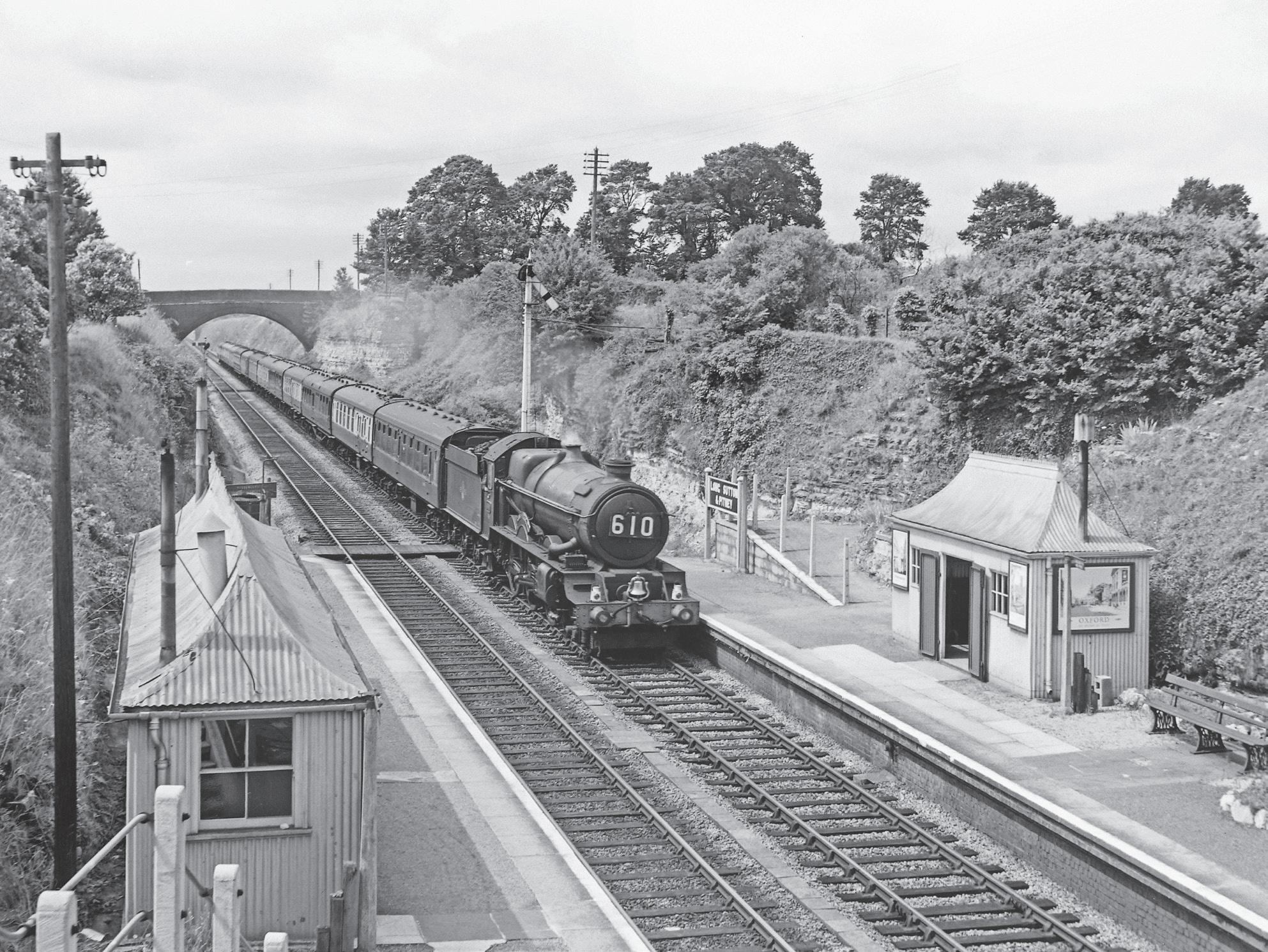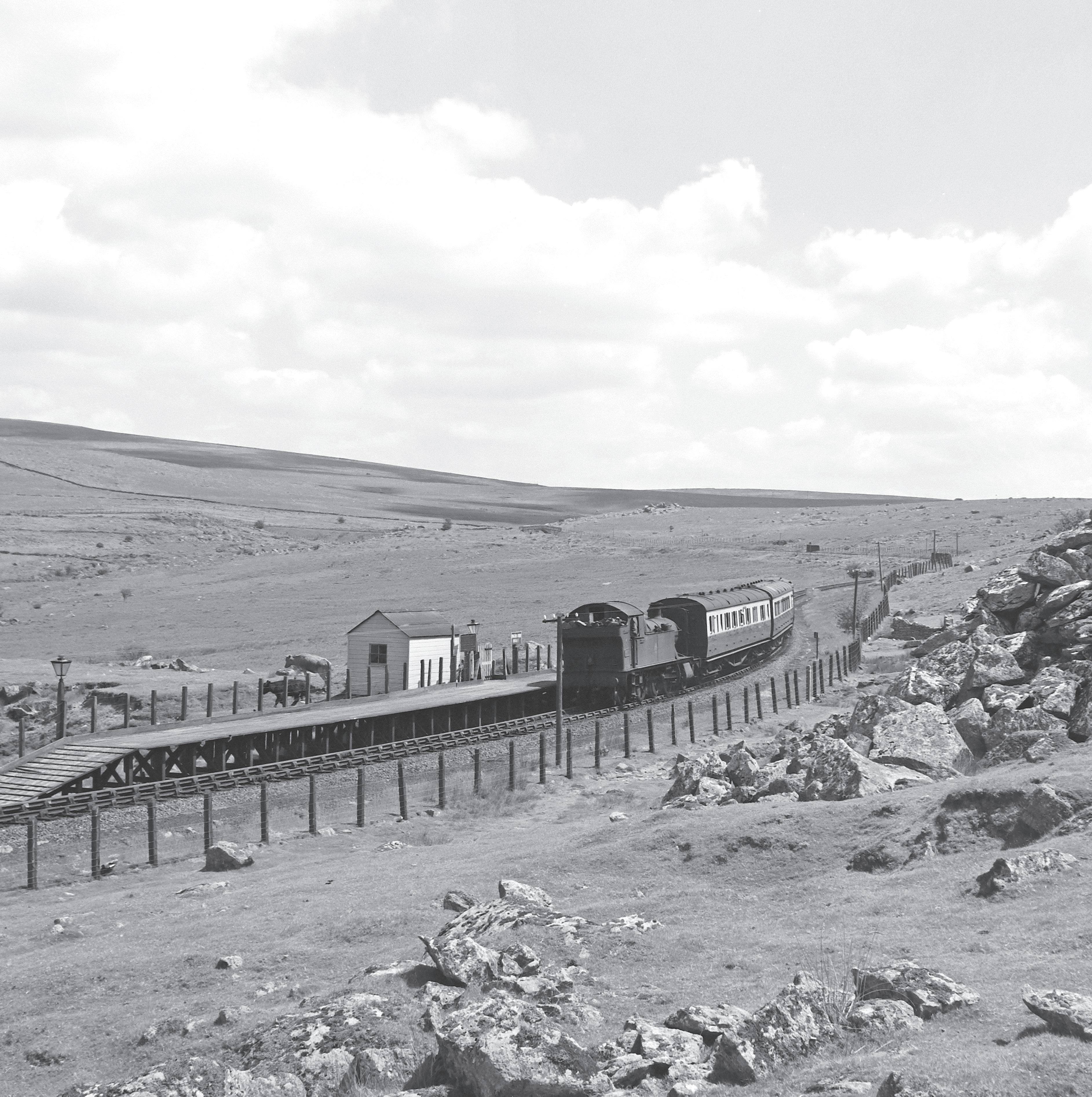

Summer on the Western
Compiled by Leslie Price

Images from the R. C. Riley Collection
Image 45. Moving further south on the same day, following the B & M into the Rhymney Valley the milepost on the ‘Down’ platform, just to the left of the locomotive, tells us, we are now five miles from Bassaleg Junction and thus seven and three quarter miles from Newport. This is Machen. ‘57xx Class’ Pannier Tank No 7781; one of the same batch as sister engine No 7776 in Image 34, runs into the station on an ‘Up’ train. Note the guard’s head is already out of the window as the train runs in. ‘Mynydd Machen’, 1,188 ft. high, dominates the background. Like its classmate, it was delivered into service from Armstrong Whitworth in November 1930 and probably went directly to Ebbw Junction shed at Newport (NPT and then 86A). On very close inspection the grimy shed code plate does look like 86A. This engine was sighted on that shed ten times during various Sundays from 1944 through to 18 July 1960 when it was withdrawn from service, perhaps indicating it was a resident engine. Built with vacuum brakes and steam heating apparatus, ATC (Automatic Train Control) equipment was added on arrival from Armstrong’s at Swindon (as were all later locomotives supplied by contractors) before entering service. The ‘57xx’s’ were not as glamorous as the GWR ‘Castles’ and ‘Kings’ but became just as much an icon of the GWR, despite many of their lives working in the Valleys amongst coal and grime. Although officially designated as “light goods and shunting engines”, they were also used for passenger workings on branch, suburban, and shorter mainline journeys. They were never fitted with remote control gear for working auto-trains so the locomotive would have to run round its train at each destination. Dick’s notes state only that this is ‘a Pass. ex-Caerphilly’ which possibly indicates an ex-New Tredegar or PontypriddNewport branch train. Once again note the ‘Virol’ sign (see Images 29 and 37). (RCR2220)


Image 69. On returning to Dick’s journey on 2 July 1955, continuing working his way slowly west, one of his points of call was Keinton Mandeville. Quite clearly from 1946 he was one of the few able to afford a car. By 1952 this was a Morris Minor Tourer Convertible. In the context of the increasing contest between road and rail transport, Dick, probably quite unwittingly, took this photograph. It is a perfect illustration of the dilemma facing the railway authorities in the mid- 1950s. In this picture the road has a single user conveyance; it could just as easily have been a bus. The train is virtually empty; only two or three passengers can be seen. It was this kind of situation which prompted the Beeching Report of 1963. The village of Keinton Mandeville is approximately five miles west of Castle Cary. In his notebook Dick records “Auto 3.35pm”, which would indicate the train was likely to be the 2.38pm Taunton- Castle Cary Auto, due at Keinton Mandeville at 3.32pm. Although the timings of these workings varied throughout the

period they did, nevertheless, run in more or less the same pathway. The locomotive in charge is another Charles Collett ‘54xx Class’ No 5402. From records it can be established that throughout the decade No 5402 was consistently noted on shed both at Taunton and Westbury each time displaying a Westbury (82D) shed code plate which suggests that it regularly ‘ploughed this furrow’. At the time of nationalisation the service comprised of five trains each way on Weekdays and one return service between Castle Cary and Langport East on Sunday afternoons. The timetable remained much the same until withdrawal of the service on10 September 1962, just prior to Dr. Beechings’s Report. Except, that by then there were no Sunday trains and the weekday service had been severely reduced, one of those withdrawn being the subject of this picture. (RCR6190)
Image 70. A further seven miles west was Long Sutton & Pitney; we are now almost 114 miles from Paddington. Evident from this picture Long Sutton & Pitney was a quintessential Great Western Railway wayside station kept in pristine condition, served by the same auto-train service as seen in the previous image. Set in a cutting each platform was provided with a pagoda type waiting room. Complete with sliding doors which could be closed when the station was not in use, each also had a tall chimney indicating that both had heating facilities. Steps and ramps provided access from the road bridge from where this photograph was taken on Saturday 26 July 1958. Note also the platform bench seat with the GWR monogram formed into its iron footings. Invading this otherwise tranquil scene comes a ‘King Class’ locomotive proudly displaying a bell on its front buffer beam. Of course, this can only be No 6000 King George V. It was bestowed this bell when attending the Baltimore and Ohio Railroad’s centenary celebrations in 1927. Here she is heading TRN ‘610’, comprising thirteen or fourteen coaches, exactly the type of train she was designed for. In the 1958 summer timetable this was the 8.15am (SO) Perranporth to Paddington; making the time of the picture around 1.15pm. Perranporth was a relatively insignificant little station on the Truro to Newquay branch line but such was the attraction of Cornwall to the 1950s holiday-maker that it warranted its own Saturdays only train to convey them back to London. Undoubtedly the train would have picked up other portions on its route. The ‘King’ would have taken over the train at Plymouth and was now working back home to Old Oak Common (81A). (RCR12505)

Image 71. From Long Sutton and Pitney we now travel direct to Whiteball, south of Wellington on the Somerset-Devon border. Whiteball Siding Signal Box marked the summit of a nine mile climb from Norton Fitzwarren, with a ruling gradient of 1 in 80 on the approach to Whiteball Tunnel seen in the background. This 1088 yards long tunnel was itself set on a gradient of 1 in 82. So Whiteball was an ideal spot for railway photography and Dick took full advantage of this. In 1954 he took his summer holiday during the last week in August and the first in September. Here on the penultimate day, Saturday 4th September, he captured this rather artistic view of a train surmounting Whiteball summit. This location obviously became a chosen spot on his way back home after his forays to the west during his summer holidays. On this occasion he recorded one of the final series of the ‘Castles’ No 7004 Eastnor Castle. It is in charge of ‘The Cornishman’; TRN ‘820,’ the 8.55am (SO) Wolverhampton (Low Level)-Penzance. It must be warm; the engine’s exhaust is almost imperceptible. The driver is hanging out of the cab almost as if he is reassuring himself the ‘Down’ home signal is showing ‘road clear’ or is he worried about Dick crouching in the cess to get his photograph, so close to the running line? From the summer timetable 1952 the title ‘The Cornishman’ was bestowed on the 9am (Weekdays only) Wolverhampton to Penzance. This through refreshment car train, designated TRN ‘825’, also carried through coaches for Newquay. It continued to run on Saturdays only during the 1952 winter service, now leaving Wolverhampton at 8.55am. From the commencement of the summer service in 1953 the weekday departure time reverted to 9am but the Saturday train took the 8.55am slot and became ‘820’. The arrangement continued throughout the middle of the decade. 7004 was an Old Oak Common (81A) based engine from 1949 through to 1960 so why she was working this train is an intriguing question. (RCR5440)

Image 110. From Dousland, Dick then moved further up onto Dartmoor and captured this panoramic view of Ingra Tor Halt; showing its remoteness in the barren wilderness that is Dartmoor. This was the next halt on the route and here he recorded the return working, the 12.8pm from Princetown due here at 12.22pm. Note it is now hauling two coaches, presumably having collected the second one at Princetown after the outward journey. The tortuous nature of the line is obvious. Rising to the left in the background is Ingra Tor itself, sitting 1,273 feet (388 m) above sea level. The Halt stood at over 984 feet (300 m) and was inaccessible by road. This Halt together with the following one, King Tor, was opened by the GWR in 1936 largely to attract walkers. But in the case of Ingra Tor, the original reason was in connection with the short-lived re-opening of the adjacent quarry. Dick notes the Halt, which opened with only a basic wooden platform and shelter had a GWR notice, reading “In the interests of game preservation and for

their protection against snakes etc. dogs should be kept on a lead. By Order”. Both the shelter and platform are clearly visible in the picture; the local four-legged residents running wild on the moor would have little requirement for either! The forerunner to the Princetown Railway was the Plymouth & Dartmoor Railway over whose route much of the branch ran. In 1823 the P&DR opened a line built to a gauge of 4ft. 6in, to improve the economy of moorland areas around Princetown. Independent carriers operated horse-drawn wagons and paid the company a toll. In 1878 the Princetown Railway paid £22,000 in shares to acquire the necessary part of the line required for their railway. Minor alignment improvements were made to accommodate locomotive working and a major section of new route was built passing east of Yennadon Down, then descending to Yelverton. It opened on 11 August 1883. (RCR6246)

Image 111. From Ingra Tor, he then drove direct to Yelverton, the junction for Princetown where the previous ‘Down’ train had arrived at 12.43pm. By now No.4410 had already had time to turn on the small turntable and was sitting in the branch platform ready to work the 2.28pm to Princetown. Contrary to usual practice, it is said that local railwaymen referred to Princetown bound trains as ‘Up’ trains and those to Yelverton as ‘Down’. The law of gravity seems to have applied. This train provided a connecting service from the 1.48pm from Plymouth (North Road). Here we have a good general view of the layout of this junction station. The wooden pentagonal waiting room provided between the platforms looks rather weather beaten and forlorn. But the station running-in board announcing ‘Yelverton Change for Dousland & Princetown’ and the adjacent pagoda shelter still look in good order. The Princetown branch had a sharply curved single platform, and the connection to the main line faced Tavistock. A 23 feet 6 inches turntable was provided at the Princetown end of the platform for turning snow-plough engines. After arriving passengers had alighted, the branch train
was propelled out of the platform towards the camera. This allowed the locomotive to run into the turntable headshunt and the carriages were allowed to gravitate back into the platform under the control of the Guard’s brake. The locomotive would then be re-attached to the Princetown end for the next journey. This was the last summer this engine would see service, it was one of a total of eleven such locomotives designed by George Jackson Churchward particularly for use in hilly districts, of which the Princetown branch was a prime example. Built at Wolverhampton Works (Stafford Road) it entered service in June 1906 and was quite possibly the last of the Class to be withdrawn, on 12 September 1955. It was just nine months short of fifty years service during which time it had travelled 993,193 miles. The ‘Class 44xx’s were the forerunners of all the subsequent developments of the GWR ‘Prairie Tanks’. In the foreground another photographer, quite likely a friend of Dick’s, checks the train service with station staff. (RCR6252)
Image 145. And so we come to the end of the line; as far as the Western tentacles stretched, just over 325 miles from Paddington via Bristol or 305 miles via the direct route. A year later than the previous image, on Thursday 12 July 1956 Dick was at Penzance to take this all encompassing view of the terminus just as No 1006 County of Cornwall, which we last saw in Image 142, was pulling away from Platform 1. In his notes he describes this train as the 1.55pm passenger to Newton Abbot. This was another long standing fixture in the timetable throughout the decade, calling at virtually all stations en route, but by the 1960 timetable had been cut back to terminate at Plymouth. Meanwhile, across in the curving Platform 4, ‘Castle’ No 5003 Lulworth Castle waits time with the 2.0pm ‘Perishables’ to Crewe. No 5003 was based at Exeter (83C) from 27 February 1951 through to 9 February 1957 so was possibly taking the train as far as that point. Further over a ‘Pannier’ tank sits at the head of what appears to be a milk tank and a number of vans in the parcels dock. It is intriguing to note that apart from a five month spell at Carmarthen (87G), in 1954, County of Cornwall spent all her service in the West Country being based no farther east than Newton Abbot (83A). So the majority of the 687,685 miles she accumulated during her working life were run over tracks west of the Tamar. Whether her placement was a case of operational exigencies or political expediency is a matter of conjecture. Prior to the date of this shot No 1006 had become re-allocated to Penzance during September 1955. Penzance was a busy shed; as well as looking after its own allocation of engines, it dealt with daily arrivals for servicing from visiting engines such as Lulworth Castle above. County of Cornwall was still allocated to Penzance in 1959 together with three other ‘Counties’, two ‘Castles’, six ‘Halls’, twelve ‘Granges’ and a variety of ten tank engines; a total allocation of 34 locomotives. (RCR7607)



Each generation often looks back wistfully to its youth, and for many, the 1950s and 60s represent a golden era. This book captures that essence through the lens of Richard Charles “Dick” Riley, one of the most accomplished railway photographers. Growing up when children could freely explore the countryside, Riley’s work immortalises these moments for future generations. Born in 1921 in South London, Riley’s daily commutes to school sparked a lifelong passion for steam engines, particularly the Great Western Railway (GWR). His photographs, predominantly in black and white, reflect the simplicity and charm of an era when colour photography was still in its infancy. Riley’s meticulous notes and contemporary timetables allow us to dive deep into the details of each scene he captured.
This book takes readers on a journey across post-WWII Britain’s Western Region during the 1950s and early 60s. From Paddington to the serene landscapes of Wales and the picturesque routes to Penzance, Riley’s camera documented a time when railways were the nation’s lifeblood. His personal vehicle, a Morris Minor Convertible, enabled him to explore remote parts of the Western Region, capturing the essence of a rapidly changing world. Riley’s photographs range from the quiet solitude of Abbotsbury to the rugged beauty of Dartmoor and the industrial valleys of South Wales. These images, many of which have been featured in various publications, now come together to offer a deeper insight into his work.
ISBN 978-1-913251-78-9

£29.95


